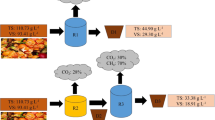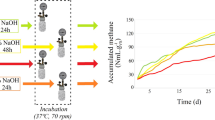Abstract
In this study, biogas and biomethane production during mesophilic anaerobic digestion of wheat substrates coming from national crops and naturally contaminated with deoxynivalenol (DON) and/or T-2/HT-2 toxins was investigated. Biochemical methane potential (BMP) tests of both wholewheat flour and of the main milling fractions were carried out to assess the effect on the concentration of mycotoxins on the anaerobic biological process and their residual presence in the final digestate. The good methane average production achieved (337.0 ± 24.5 NL CH4/kg VS) was substantially comparable with the yields gained from similar biomasses at mesophilic conditions. Moreover, an effective reduction (60.7–100%) of DON concentration was obtained in all the tested substrates (range of contamination in the samples, 368–12,916 μg/kg) whereas the sum of T-2 and HT-2 toxin levels in digestates was always <LOQ in all substrates analyzed (range of contamination in the samples, 5–65 μg/kg). The results supported an alternative exploitation of “non-compliant” lots of cereals destined for human consumption and/or animal feed which could represent a concrete benefit for agricultural producers. Anaerobic digestion could be employed as an effective tool to recover large amounts of trichothecene-contaminated cereals in an environmentally and economically sustainable way.






Similar content being viewed by others
References
Stroka J, Gonçalves C (2019) Mycotoxins in food and feed: an overview. Encycl Food Chem 1:401–419. https://doi.org/10.1016/B978-0-08-100596-5.21801-5
European Union (2019). The rapid alert system for food and feed — 2018 annual report. https://ec.europa.eu/food/sites/food/files/safety/docs/rasff_annual_report_2018.pdf
European Union (2018). The rapid alert system for food and feed — 2017 annual report. https://ec.europa.eu/food/sites/food/files/safety/docs/rasff_annual_report_2017.pdf
European Union (2017). The rapid alert system for food and feed — 2016 annual report. https://ec.europa.eu/food/sites/food/files/safety/docs/rasff_annual_report_2016.pdf
Pinotti L, Ottoboni M, Giromini C, Dell’Orto V, Cheli F (2016) Mycotoxin contamination in the EU feed supply chain: a focus on cereal byproducts. Toxins 8:45. https://doi.org/10.3390/toxins8020045
Eskola M, Kos G, Elliott CT, Hajšlová J, Mayar S, Krska R (2019) Worldwide contamination of food-crops with mycotoxins: validity of the widely cited ‘FAO estimate’ of 25%. Critical reviews in Food Science and Nutrition. https://doi.org/10.1080/10408398.2019.1658570
Agriopoulou S, Stamatelopoulou E, Varzakas T (2020) Advances in occurrence, importance, and mycotoxin control strategies: prevention and detoxification in foods. Foods 9(2):137. https://doi.org/10.3390/foods9020137
Nazari L, Pattori E, Terzi V et al (2014) Influence of temperature on infection, growth, and mycotoxin production by Fusarium langsethiae and F. sporotrichioides in durum wheat. Food Microbiol 39:19–26. https://doi.org/10.1016/j.fm.2013.10.009
Aureli G, Amoriello T, Belocchi A et al (2015) Preliminary survey on the co-occurrence of DON and T2+HT2 toxins in durum wheat in Italy. Cereal Res Commun 43:481–491. https://doi.org/10.1556/0806.43.2015.01
Antonissen G, Martel A, Pasmans F et al (2014) The impact of Fusarium mycotoxins on human and animal host susceptibility to infectious diseases. Toxins 6:430–452. https://doi.org/10.3390/toxins6020430
Yazar S, Omurtag GZ (2008) Fumonisins, trichothecenes and zearalenone in cereals. Int J Mol Sci 9:2062–2090. https://doi.org/10.3390/ijms9112062
Pinton P, Oswald I (2014) Effect of deoxynivalenol and other type B trichothecenes on the intestine: a review. Toxins 6:1615–1643. https://doi.org/10.3390/toxins6051615
Gauthier T, Waché Y, Laffitte J et al (2013) Deoxynivalenol impairs the immune functions of neutrophils. Mol Nutr Food Res 57:1026–1036. https://doi.org/10.1002/mnfr.201200755
Scientific Committee on Food SCF/CS/CNTM/MYC/27 (2002) Final opinion of the Scientific Committee on Food on Fusarium toxins. Part 6: group evaluation of T-2 toxin, HT-2 toxin, nivalenol and deoxynivalenol.
Maresca M (2013) From the gut to the brain: journey and pathophysiological effects of the food-associated trichothecene mycotoxin deoxynivalenol. Toxins 5:784–820. https://doi.org/10.3390/toxins5040784
Bertero A, Moretti A, Spicer L, Caloni F (2018) Fusarium molds and mycotoxins: potential species-specific effects. Toxins 10:244. https://doi.org/10.3390/toxins10060244
Commission of the European Communities 2006. Commission Regulation (EC) N. 1881/2006. Official J. of the European Union L. 364/5. (2006) Commission Regulation (EC) No 1881/2006 of 19 December 2006 setting maximum levels for certain contaminants in foodstuffs. Off J Eur Union 364:5–24.
Commission of the European Communities (2006) Commission Regulation (EC) N. 1126/2007 of 28 September 2007 amending Regulation (EC) No 1881/2006 setting maximum levels for certain contaminants in foodstuffs as regards Fusarium toxins in maize and maize products. Off J Eur Union 255:14–17
Commission Recommendation (2013/165/EU). Commission Recommendation 2013/165/EU of 27 March 2013 on the presence of T-2 and HT-2 toxin in cereals and in cereal products. Off J Eur Union 91:12–15.
European Food Safety Authority (2011) Scientific opinion on the risks for animal and public health related to the presence of T-2 and HT-2 toxin in food and feed. EFSA J 9:2481. https://doi.org/10.2903/j.efsa.2011.2481
European Food Safety Authority (2017) Scientific opinion on the risks to human and animal health related to the presence of deoxynivalenol and its acetylated and modified forms in food and feed. EFSA J 15:4718. https://doi.org/10.2903/j.efsa.2017.4718
Pettersson H (2011) Toxicity and risks with T-2 and HT-2 toxins in cereals. Plant Breed Seed Sci 64:65–74. https://doi.org/10.2478/v10129-011-0029-7
Hassan YI, Zhou T (2018) Promising detoxification strategies to mitigate mycotoxins in food and feed. Toxins 10:116. https://doi.org/10.3390/toxins10030116
Karlovsky P, Suman M, Berthiller F, De Meester J, Eisenbrand G, Perrin I, Oswald IP, Speijers G, Chiodini A, Recker T, Dussort P (2016) Impact of food processing and detoxification treatments on mycotoxin contamination. Mycotoxin Res 32:179–205. https://doi.org/10.1007/s12550-016-0257-7
Adhikari M, Negi B, Kaushik B, Adhikari A, Al-Khedhairy AA, Kaushik NK, Choi EH (2017) T-2 mycotoxin: toxicological effects and decontamination strategies. Oncotarget 8:33933–33952. https://doi.org/10.18632/oncotarget.15422
Ministerial Decree (2016) Ministerial Decree n. 5046 of 25 February 2016 - Criteria and general technical rules for the regional regulation of agronomic use of livestock manure and waste water, as well as for the production and agronomic use of digestate. (G.U. 18 April 2016, n. 90, S.O.) www.gazzttaufficiale.it/eli/id/2016/04/18/16A02762/sg
Giorni P, Pietri A, Bertuzzi T et al (2018) Fate of mycotoxins and related fungi in the anaerobic digestion process. Bioresour Technol 265:554–557. https://doi.org/10.1016/j.biortech.2018.05.077
Goutex et al. (2010) Deoxynivalenol concentration decrease during mesophilic anaerobic digestion of wheat flour. Proc 3th Int Symp Energy from Biomass Waste. Venice, Italy
Commission Regulation (EC) N. 401/2006 of 23 (February 2006) laying down the methods of sampling and analysis for the official control of the levels of mycotoxins in foodstuffs. European Commission. Off J Eur Union 70:12–34
Bertuzzi T, Camardo Leggieri M, Battilani P, Pietri A (2014) Co-occurrence of type A and B trichothecenes and zearalenone in wheat grown in northern Italy over the years 2009–2011. Food Addit Contam: Part B Surveill 7(4):273–281. https://doi.org/10.1080/19393210.2014.926397
Blandino M, Fabbri C, Soldano M et al (2016) The use of cobs, a by-product of maize grain, for energy production in anaerobic digestion. Ital J Agron 11:195–198. https://doi.org/10.4081/ija.2016.754
Langone M, Soldano M, Fabbri C et al (2018) Anaerobic digestion of cattle manure influenced by swirling jet induced hydrodynamic cavitation. Appl Biochem Biotechnol 184:1200–1218. https://doi.org/10.1007/s12010-017-2612-3
Holliger C, Alves M, Andrade D et al (2016) Towards a standardization of biomethane potential tests. Water Sci Technol 74:2515–2522. https://doi.org/10.2166/wst.2016.336
Raposo F, Fernández-Cegrí V, de la Rubia MA et al (2011) Biochemical methane potential (BMP) of solid organic substrates: evaluation of anaerobic biodegradability using data from an international interlaboratory study. J Chem Tech Biotech 86:1088–1098. https://doi.org/10.1002/jctb.2622
Koch K, Hafner SD, Astals S, Weinrich S (2020) Evaluation of common supermarket products as positive controls in biochemical methane potential (BMP) tests. Water 12(5):1223. https://doi.org/10.3390/w12051223
Schothorst RC, Van Egmond HP (2004) Report from SCOOP task 3.2.10 “Collection of occurrence data of Fusarium toxins in food and assessment of dietary intake by the population of EU member states” Subtask: Trichothecenes. In: Toxicology Letters 153(1):133–143
Soldano M, Labartino N, Fabbri C, Piccinini S (2012) Biochemical methane potential (BMP) test of residual biomass from the Agro-food Industry. Proc Int Conf 20th European Biomass Conference and Exhibition, Milan, pp 1420–1423. 10.5071/20theubce2012-2dv.3.9
Koch K, Hafner SD, Weinrich S, Astals S (2019) Identification of critical problems in biochemical methane potential (BMP) tests from methane production curves. Front Environ Sci 7:178. https://doi.org/10.3389/fenvs.2019.00178
De Gelder L, Audenaert K, Willems B, Schelfhout K, De Saeger S, De Boevre M (2018) Processing of mycotoxin contaminated waste streams through anaerobic digestion. Waste Manag 71:122–128. https://doi.org/10.1016/j.wasman.2017.09.039
Morcia C, Tumino G, Ghizzoni R et al (2016) Occurrence of Fusarium langsethiae and T-2 and HT-2 toxins in Italian Malting Barley. Toxins 8:247. https://doi.org/10.3390/toxins8080247
E FAO and WHO. 2019. Hazards associated with animal feed. Report of the Joint FAO/WHO expert meeting – 12–15 May 2015, FAO headquarters, Rome, Italy. FAO Animal Production and Health Report No. 13. Rome
Brera C, Debegnach F, De Santis B, Pannunzi E, Berdini C, Prantera E MM (2009) Validazione di metodi immunoenzimatici per la determinazione delle micotossine in campioni di cereali. I quaderni dei georgofili 2008–IV:23–45
(May 2014) Pascale M, Aureli G, Haidukowski M, Melloni S, D’Egidio M G VA (2014) Comparison between ELISA and UPLC methods for the determination of T-2 and HT-2 toxins in wheat. Int Mycotoxin Conf 19–23. Beijing, PR China, Book of Abstracts:258
Acknowledgments
The authors thank Fabrizio Quaranta and Francesca Nocente for the help provided, and Alessandra Arcangeli and Roberto Mortaro for the technical support.
Funding
This work was supported by the Italian Ministry of Agriculture (MiPAAF) under the AGROENER project (D.D. no. 26329, 1 April 2016)—http://agroener.crea.gov.it/.
Author information
Authors and Affiliations
Corresponding author
Additional information
Publisher’s Note
Springer Nature remains neutral with regard to jurisdictional claims in published maps and institutional affiliations.
Rights and permissions
About this article
Cite this article
Soldano, M., Pietri, A., Bertuzzi, T. et al. Anaerobic Digestion of Mycotoxin-Contaminated Wheat: Effects on Methane Yield and Contamination Level. Bioenerg. Res. 14, 313–321 (2021). https://doi.org/10.1007/s12155-020-10161-4
Received:
Accepted:
Published:
Issue Date:
DOI: https://doi.org/10.1007/s12155-020-10161-4




